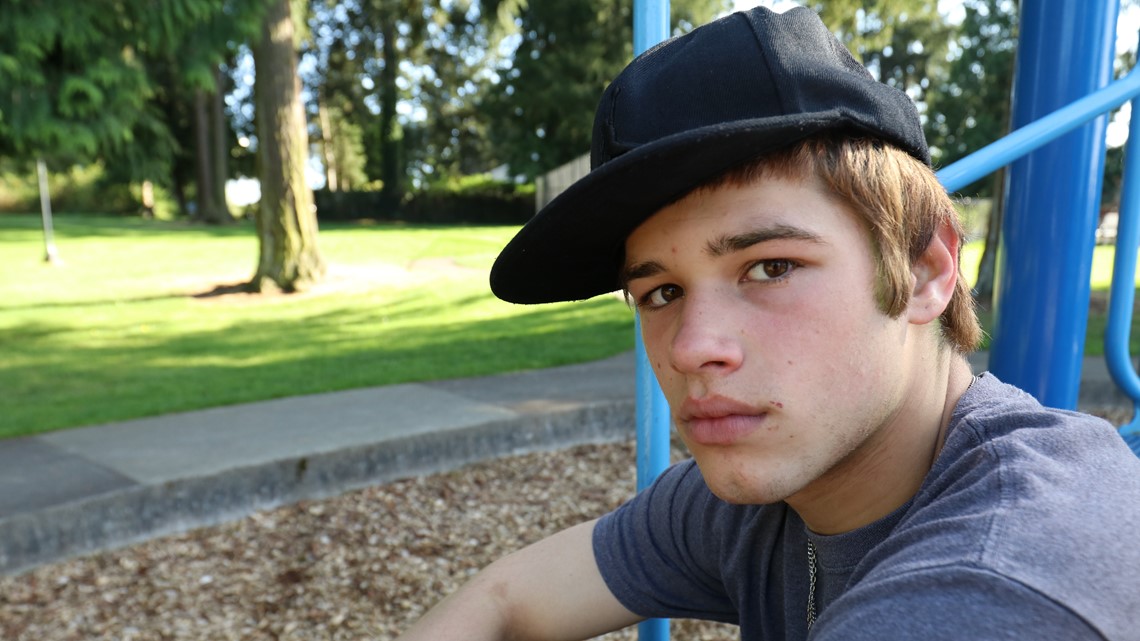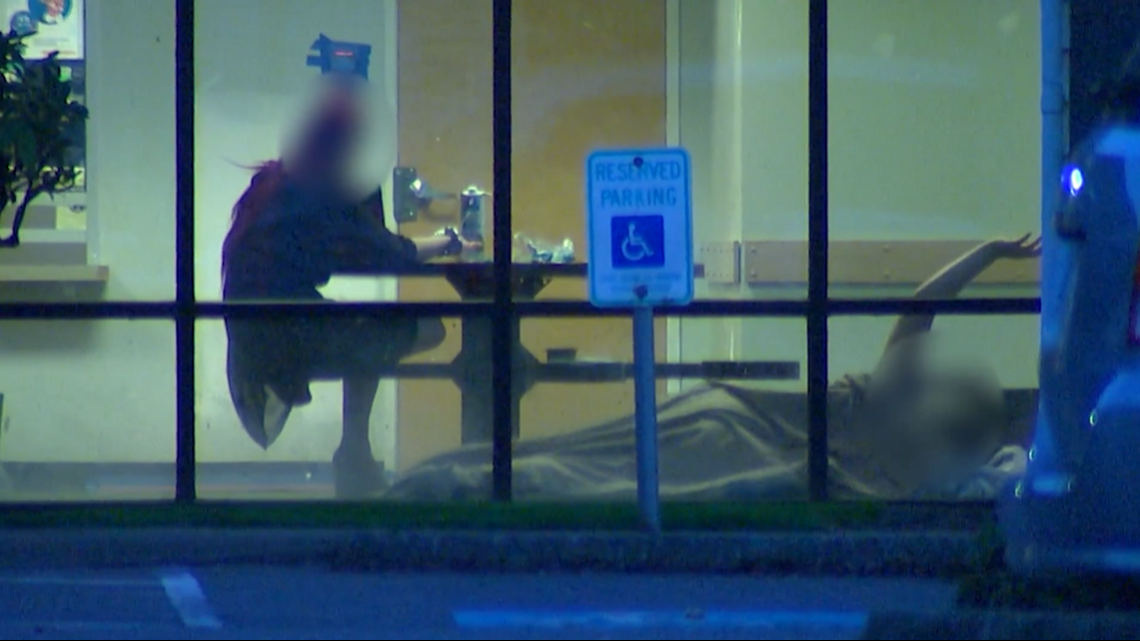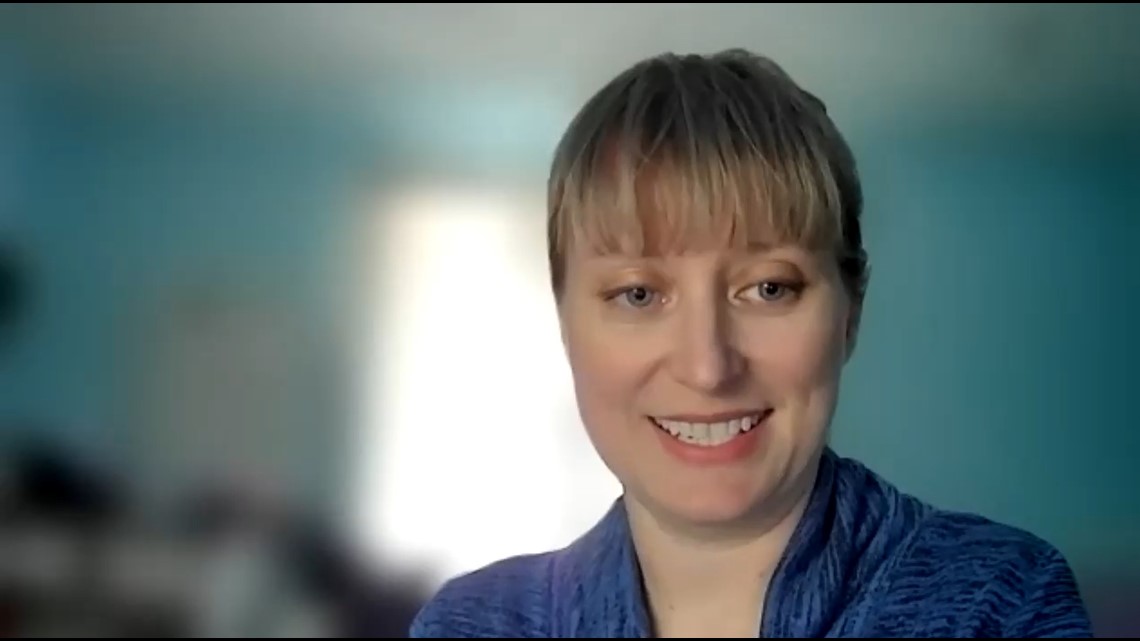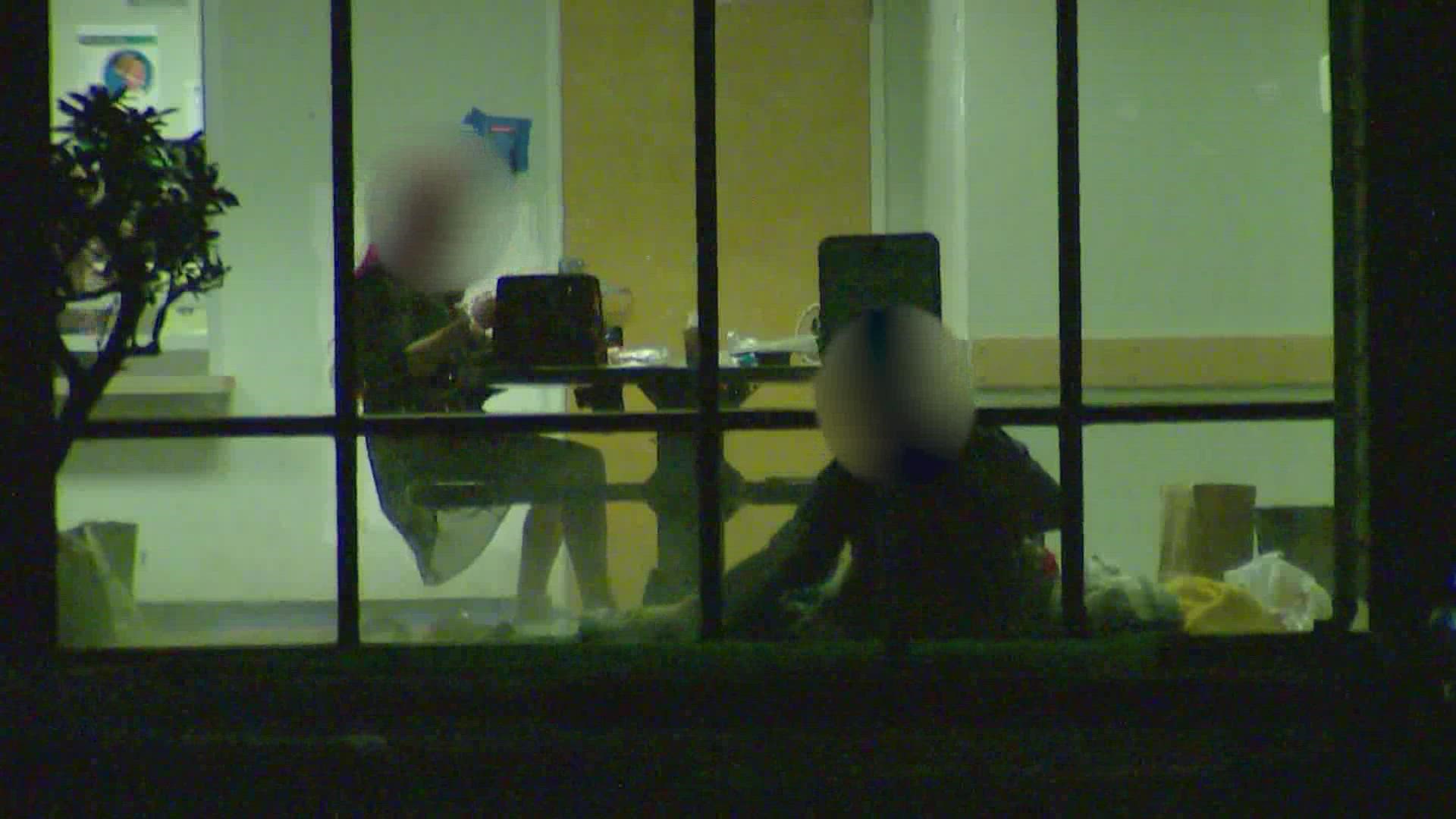Editor's note: The above video on the state's plan to meet a court deadline to end foster youth hotel stays originally aired Sept. 2, 2021.
DES MOINES, Wash. – There used to be nothing more unsettling for 15-year-old Isaac Hughes than the uncertainty of where he’d sleep each night during his childhood to early teenage years in the Washington foster care system.
All he could think about was his wish to return home.
“They were bad memories. They were like memories that I can’t get out of my head,” he said. “I'd wake up in the morning and go, like, ‘What's gonna happen? Where am I gonna go today? I don't know where I'm gonna go.”
In the span of just three years, Hughes lived in more than 40 different places — shuffling in and out of foster homes, group homes, residential behavioral health facilities and juvenile detention.


State records show, on many nights, placement specialists at the Washington Department of Children, Youth, and Families (DCYF) searched and struggled to find a foster home or a group home that would agree to take in the boy. Hughes was known to have behavioral problems, and he needed a higher level of supervision than many foster parents were willing to offer, according to a review of his Child Protective Services (CPS) records.
“I guess they were saying I was a bad kid or something, and I didn’t have a foster home to go to,” Hughes said. “They said I was too hyper, too reckless, too destructive. And I was like, ’I'm none of those things. I'm a nice kid.’”
Instead of finding stability inside a loving home where he could prosper, Hughes often found himself holed up in state office buildings as he waited for a new placement. State records show, beginning at age 10, he spent night after night with a social worker at different hotels across King County — sometimes without a change of clothes, access to his hygiene products or other belongings.


“I didn’t like it at all. They were moving me from hotel to hotel and I was eating junk food,” he said. “It made me hurt. Knowing that I don’t have a roof over my head — a place to go — you get this feeling in your body that is not good.”
Washington state is under a federal court order to make significant changes so other foster children don't have the same unstable experiences as Hughes.
In less than a month, DCYF will no longer be allowed to house foster children overnight in hotels or state offices, where the child welfare agency historically placed hundreds of kids when it had nowhere else to put them.
Grappling with a shortage of foster parents and intensive therapeutic homes, DCYF leaders have for years promised — and failed — to curb the long-standing practice, which has increased steadily over the last seven years.
A U.S. District judge signed the court order in June, which requires DCYF to cease hotel stays by Nov. 1, in addition to making a series of other sweeping changes to improve the circumstances for foster youth without placements.
In September, the department put forth its new plan to carry out the court order after meeting with attorneys who represent foster youth, service providers and others who play a role in the child welfare system.
DCYF Secretary Ross Hunter tapped his chief financial officer, Jenny Heddin, to oversee the strategy in a new temporary role as intensive placement project manager. The pair says they’re meeting weekly with about eight other leaders from across the department to review the agency’s progress with the plan, which includes hiring two new employees to help the department secure more placement options for youth with behavioral or mental health challenges.
The child welfare agency’s long-term plan focuses on solving the problem ”holistically,” Hunter said. The department is working to increase the number of available placement options for teens and high-needs children, refining existing state practices to meet the unique needs of youth and collaborating with other agencies and hospital groups to prevent youth from entering the child welfare system when there’s a better system to serve them.
“I am confident that we will be able to solve this problem,” Heddin said.
But as hotel stays persist ahead of the looming deadline, some child welfare experts, attorneys and providers are skeptical.
“I support and respect what they put in the plan,” said Leslie Briner, a Seattle-based sexual exploitation and trafficking consultant who has worked for years with the state’s at-risk foster youth. “But I don’t see anything particularly innovative.”
Briner and others are questioning whether DCYF has come up with enough new ideas in its six-page plan to permanently solve an old and challenging problem.
“I’m not optimistic,” said Patrick Dowd, director of the Washington Office of the Family and Children’s Ombuds.
Advocates for foster youth claim DCYF’s plan omitted important recommendations they shared with agency leaders during a series of stakeholder meetings in August.
“Our input is not reflected in the plan,” said Colleen Shea-Brown, an attorney who leads the dependency unit at the Legal Counsel for Youth and Children. “The most glaring omission is that the plan fails to mention the needs of queer youth whatsoever. That’s a big part of the population who are experiencing placement instability.”
‘We’re just going on with business as usual’
Between June 1 and Oct. 10, Washington state reported that at least 119 foster children experienced a “placement exception” — the term the state uses to describe overnight stays in hotels, offices and one-night foster home placements.
Since August, DCYF has largely stopped using offices to house foster children overnight, according to data provided by the Washington Office of the Family and Children’s Ombuds. In fact, there were six nights over the summer when the agency reported it had no youth sleeping in hotels or offices.
But state officials are still, on average, placing about 10 foster children in hotels almost every night, the ombuds’ data shows. It’s a reality that has some foster youth advocates and frontline child protection workers feeling hopeless that DCYF will change its ways.
“To me, it still looks the same,” said a current after-hours social worker who still regularly supervises foster youth in King County hotels. “We’re just going on with business as usual. I was anticipating more of a change.”
Hunter said it's too soon to know if his agency will meet the federal judge's deadline to stop using hotels.
“I don’t want to over promise,” Hunter said in an Oct. 6 interview with KING 5. “We are working as hard as we can to make that happen. It’s a complicated arrangement.”
In an internal Oct. 14 email sent to DCYF after-hours employees in King County, a manager for the agency braced her staff that the court order was unlikely to change the current situation when November strikes.
“The reality is...we will have youth who are going to continue to refuse placements and a lack of placement resources,” Stephanie Long, a DCYF area administrator, wrote in the email obtained by KING 5. “With us in the field, I do not anticipate any day to day work we are doing in (the after-hours department) to change. (After hours) will continue to have youth who are not in stable placements and will need support with transportation night to night and supervised in hotels.”
DCYF’s after-hours team is responsible for transporting and supervising foster youth who don’t have a placement at a foster home or group home after 5 p.m.


A small percentage of the children who cycle through the after-hours program have developmental disabilities, severe behavioral challenges or mental health conditions, according to state research. Some of the foster children who are “hard to place” have been known to behave erratically — running away, destroying public property, assaulting state employees, harming other foster youth or hurting themselves.
“The ones that we have (in hotels) now, I’m not going to deny that these kids can have a lot of challenges,” Heddin, the intensive placement project manager, said. “If they’re easy to find placement for, that would have happened already.”
State funded for new placements but it struggles to find providers
DCYF’s exceptional placement plan promises to expand the number of service providers and foster parents serving those high-needs youth. But one of the department’s biggest hurdles will be recruiting providers at a time when few have the resources or the staffing to sign up.
“The rates we pay are simply not adequate,” Heddin said. “All of our providers are experiencing really significant workforce challenges and many providers have simply stopped providing service.”
Washington’s child welfare agency has the funding to place 21 foster children in facilities that offer a combination of behavioral rehabilitation services and intensive mental health treatment. It’s a program intended to serve youth who may be under consideration or on the waiting list for the Children’s Long-term Inpatient Program, the most intensive inpatient psychiatric treatment available to youth in Washington state.
But DCYF has only six of those 21 beds up and running. All are located at Excelsior Integrated Care, a Spokane residential treatment facility that began serving 6- to 12-year-old foster children in June.
Ryan Kiely, Excelsior’s acting executive director, said the company intends to eventually add two more beds under its contract with the state. But he acknowledged that it’s costly to run the program because it requires a high ratio of medical professionals to each child.
“We’re anticipating a financial loss from this program in the first year,” he said. “Anytime you have a 24/7 staffing model, it’s a high cost.”
Excelsior has six full-time employees and about 12 part-time staff. Kiely said the company pays its medical professionals at least $20 an hour and offers retention bonuses to keep them around. But Excelsior increasingly faces the reality that similar providers are facing, too: Area hospitals and other businesses in the community are offering more money to hire employees who have the same or fewer credentials.
“We’re really fighting uphill in a pretty big workforce crunch,” Heddin, DCYF’s intensive placement project manager, said.
It’s not just the financial burden that has deterred the department’s long-time service providers from stepping up to roll out the remaining 15 beds. Heddin said most of them don’t have the state license that is required to provide mental health services in a Washington state residential treatment facility.
“We don’t normally contract with folks who have that type of license and who are doing that type of mental health work so it’s been new for us to go out and recruit those providers or get one of our current providers to be able to have that level of skill with mental health,” she said.
Rhyther, a Seattle-based treatment center that closed its door to the state’s foster children in December 2019, is still trying to get that license almost two years after first applying. Karen Brady, Rhyther’s executive director, said the process has been costly and cumbersome to navigate.
“We just submitted (our license application) for the third time. I’m so frustrated,” Brady said. “You have a system that is not very efficient and not very collaborative, and we could sure save a lot of time and money. It’s delaying much-needed services in the community.”
Rhyther used to have a cluster of therapy buildings and residential cottages on its nine-acre campus in North Seattle, where it had 36 beds to serve foster children, including Hughes. The campus had its own school and medical professionals who were available 24/7 to work with the youth, most of whom were dealing with trauma, extreme behaviors or psychiatric conditions.
But the treatment center decided to pull out of its DCYF contract because it became too costly to operate the residential program.
Nearly two years later, Brady said Rhyther doesn’t have immediate plans to reopen its doors to Washington foster youth. The company wants the new license to create three residential treatment cottages that will serve non-state-dependent youth with eating disorders, autism, anxiety and behavioral challenges.
Still, Brady said it is critical that DCYF officials do a better job of offering “concrete support” to prospective providers as they’re navigating the licensing process.
Heddin said DCYF is hiring two people who will focus exclusively on recruiting providers and child-placing agencies. The department will also work to recruit new foster parents who are specially trained to treat high-needs youth, she said.
Through a federal grant, DCYF is funded for 15 foster care beds designed for youth with significant mental health needs. But Heddin said only one bed is in operation because there’s been little interest from foster parents.
“It’s just really, really challenging to find foster parents in general. It’s especially challenging to find foster parents that are willing to take youth who have some additional challenges, and then you throw COVID into the mix,” she said. “A lot of our foster parents have been reluctant to take young people into their homes with that going on.”
DCYF piloting new housing option for foster teens
State officials say many of the youth who end up in one-night placements don’t belong in a residential treatment program or therapeutic foster home. They are “low-risk” teenagers who the state placed in offices or hotels because they refused to accept a placement at a foster home or group home.
DCYF’s plan pledges to create a new housing option called an “Emerging Adult Transitional Living Program.” It will serve a small number of those teens who don’t want to live in a family foster home but are capable of living more independently with access to support.
“We think that having another option on the table, even if it’s only serving a small number of kids, would address a portion of the youth that we’re seeing staying in hotels right now,” Heddin said.
Heddin said the program will in some ways model another DCYF independent living program that serves a select group of 16- and 17-year-olds in the child welfare system. But the new program, she said, will cater to foster youth who need access to more intensive support.
“We would obviously have some rules and boundaries on the program,” Heddin said. “But you want to be able to offer them the ability to make some mistakes and come back and have that trusting relationship with adults, which is what these young people really need.”


DCYF is planning to contract with local organizations that already serve Washington foster children to help hammer out the details of the program. It’s still unclear which organization will manage it or what the transitional housing will look like when DCYF launches a pilot of the program in December.
Some teens in the new program could end up living in their own apartments while others may live in private rooms inside a home or facility, Heddin said.
“We really only need a handful of beds available in this program to test it out and to provide a real significant opportunity for placement for the young people that have been in hotels.”
Colleen Shea-Brown, the Seattle-based attorney who represents children and teens in the child welfare system, said she and other attorneys are supportive of this aspect of the state’s plan.
“We’re on board with that,” she said. “It’s a good idea.”
Bolstering old practices
In addition to creating a new housing option for teenagers and placing a renewed emphasis on finding more placements for youth, DCYF’s exceptional placement plan largely focuses on refining and bolstering practices it already has in place.
“We really want to focus on… good case practice,” Heddin said. “Things like revisiting potential options for youth, including going back to their biological families, going to live with a kin that they maybe have some sort of relationship with. Or was there somebody else in that child’s life — maybe a former foster parent — that we can go and reach out to and talk to again?”
Agency leaders have promised DCYF staff will meet directly with foster youth and their attorneys whenever the children lack a stable placement. They say they will work with the youth to determine what types of placements might be appealing.
The meetings have long been required in DCYF policy. But department officials admit they have not always taken place consistently. The court order calls for the meetings to happen at prescribed timeframes and the state must keep track of whenever they occur.
Shea-Brown, the dependency attorney, said from her experience, the conversations typically don’t end well.
“Those meetings really can be an opportunity to problem solve and engage with young people,” Shea-Brown said. “But what we see, especially when people are kind of panicked in a crisis mode, is that those meetings often end up being a group of adults trying to strong-arm the kid into going to a placement and trying to kind of bully them into accepting it.”
It’s common for youth in the state’s care to refuse placements for various reasons. For some kids, it’s too much to fathom giving up cell phones, following rigid group home rules or moving far away from the only friends and family members they’ve ever known. Others turn down placements because they don’t feel safe or because they’ve had negative past experiences in those homes.
“Even when we have placement options for young people, I am sure that there will be scenarios where a young person looks at a caseworker and says, ‘I don’t want to go there,’” said Hunter, the DCYF secretary. “I don’t know how you get to a place where you can say 100%, ‘I am going to make every single teenager happy.'”
Shea-Brown said the state must do more to present its foster youth with acceptable options.
“What we expressed in the meeting that we had with the senior leadership folks is that really what is needed here is cultural change. The bottom line is that we need to be nice to kids and we need to listen to them. And when they say they’re unsafe, that means they’re unsafe,” she said. “They want and need homes — not beds.”
Patrick Dowd, DCYF’s ombuds director, said it’s worthwhile for the department to strengthen its existing tools and partnerships. But bolstering historic practices won’t be enough to address the problem of children sleeping in hotels.
“I think those (meetings) are good steps. But as far as answering the question of, ‘Does that increase the availability of placements that we have right now?' In my view, the answer is no,” he said.


In 2014, Dowd began tracking the number of nights foster youth spent in hotels and offices. He watched the numbers soar from just 120 nights in fiscal year 2015 to more than 2,500 nights in fiscal year 2021.
At the same time DCYF stopped using office stays in August, it began tracking how often it places youth in foster homes and group homes for only one night. Between Aug. 1 and Oct. 10, there were 34 nights when DCYF placed foster children in night-to-night placements at foster homes or group homes. Twenty-two children experienced one-night placements during this timeframe, according to the ombuds’ state data.
Both Dowd and Shea-Brown said they’re concerned DCYF will come to rely on those night-to-night placements instead of hotels and offices. The switch would “get around semantics” so the state could technically comply with the court order. But the pair said it would not improve stability or outcomes for the state’s foster children.
“These are foster homes that at 10, 11 o'clock at night will say, ‘For X number of dollars, I’ll take the kids for the night,’” Shea-Brown said. “It’s this underground backdoor way to make it look like they are complying with not putting youth in hotels…But from the perspective of our clients, it’s not better.”
Heddin, who has been reviewing the state’s placement exception data since July, said she and other DCYF leadership agree that shifting from hotel stays to night-to-night placements isn't an acceptable solution to the problem.
“The agency is obviously committed to finding safe and stable placement for these young people,” she said. “That's really what ultimately has to happen.”
After three years of instability in foster care, Isaac Hughes finally got his wish. He moved back home with his mother and father in June 2020, and the department dismissed the family’s dependency case this year.
“I was treated like I was some little kid out on the streets, like some person that doesn’t exist,” he said. “Now I sleep in a comfortable bed at night and I have my own room.”


Hughes started high school last year after missing out on a consistent education in the child welfare system. He and his twin brother regularly hit up the neighborhood basketball court after class. He said he also spends his time playing other sports, like football, soccer and swimming.
But while trying to move on from the uncertainty of his past, Hughes said his unsettling memories of night-to-night placements live on.
“The people who did this stuff to me, they like traumatized my life,” he said. “Yeah, I still think about it.”
If you’re interested in becoming a Washington state foster parent, here’s how to contact the Department of Children, Youth, and Families to get more information about next steps.
KING 5 Investigative Reporter Chris Ingalls contributed to this report.
Taylor Mirfendereski is a KING 5 investigative reporter, who specializes in multimedia storytelling, longform reporting and digital projects. Follow her on twitter at @taylormirf. E-mail her at tmirfendereski@king5.com or contact her via Signal at 206-348-4106.

